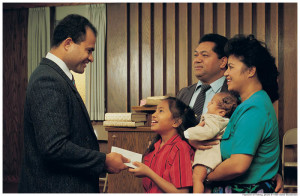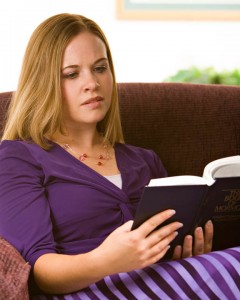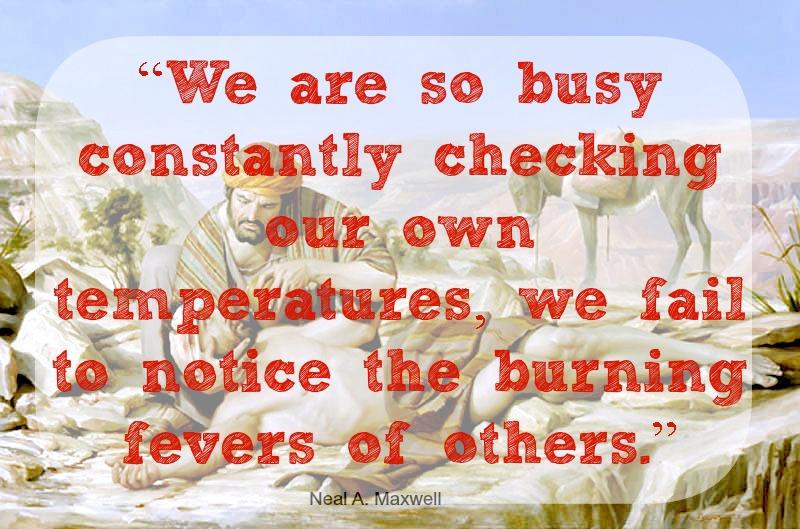
by Gale | Apr 16, 2013 | About Mormons
Many people think of sacrifice as an old-fashioned thing. In the Bible it seems to be something confined to the Old Testament, done away with in Christ’s “new law.” When the ancient Israelites failed to qualify to “enter into God’s rest,” He gave them a “schoolmaster law,” which was a law of outward ordinances. Rituals, and practices, and patterns of religious behavior were all symbolic of the Christ, a preparation for the higher law to come. When Jesus was offered up, He became the great and last sacrifice by the shedding of blood, and asked us to come unto Him with a broken heart and a contrite spirit, and to place our sins upon the altar. As we progress, we are also able to place our will upon the altar, and to surrender our lives to His service.
What then of sacrifice? Sacrifice means giving up something for a higher good. When one considers the two levels of priesthood, the Aaronic or lower priesthood, and the Melchizedek, or higher priesthood, sacrifice couples with repentance as Aaronic principles. They are foundational—the floor of the eternal, precious edifice that is the gospel of Jesus Christ. Upon them, we build on a sure foundation, adding the Gift of the Holy Ghost, our desires to reconcile with God, and our surrender to His will.
In Mormonism, which is the Church of Jesus Christ restored in it’s fullness in these last days before His Second Coming, Latter-day Saints exercise the principle of sacrifice in many ways.
Tithing
 Tithing is by definition one tenth of one’s increase, and has always been a law of the gospel. A person who pays tithing in the proper spirit realizes that all he or she has comes from God, and that all He requests is one tenth in return as an offering. By living this law, followers of the Savior reap the blessings He has promised to the obedient. In fact, He blesses us so much, that we are again in His debt. The paying of tithing is ennobling. Tithe payers increase in humility, sensitivity to the Spirit, faith, and patience, even as they are blessed line upon line with the doctrines of the kingdom, and even with worldly sustenance. This is not a prosperity gospel, but a sustenance promise. Those full-tithe-payers who have faced financial emergencies have been rescued time after time by miraculous means. (more…)
Tithing is by definition one tenth of one’s increase, and has always been a law of the gospel. A person who pays tithing in the proper spirit realizes that all he or she has comes from God, and that all He requests is one tenth in return as an offering. By living this law, followers of the Savior reap the blessings He has promised to the obedient. In fact, He blesses us so much, that we are again in His debt. The paying of tithing is ennobling. Tithe payers increase in humility, sensitivity to the Spirit, faith, and patience, even as they are blessed line upon line with the doctrines of the kingdom, and even with worldly sustenance. This is not a prosperity gospel, but a sustenance promise. Those full-tithe-payers who have faced financial emergencies have been rescued time after time by miraculous means. (more…)

by byustudent | Apr 11, 2013 | About Mormons
As school comes to an end, I really feel like the messages that I continue to learn through my study of the Book of Mormon become stronger and stronger. I can tell that the Lord wants me to prepare for what life has ahead of me.
 This week, I was pondering the question, “Why does the Book of Mormon contain so much war and fighting?” Specifically, I wanted to know how do these stories of battle apply to us. It was this thinking that brought me to an answer found in Ether 8. In verse 26, Moroni (whom after studying so much I have found to be a great writer and very influential on me) states,”… am commanded to write these things that evil may be done away, and that the time may come that Satan may have no power upon the hearts of the children of men…” Once again, Moroni makes no doubt in his words. He has been commanded by the Lord to tell us about these wars for our own recognition of evil. The Lord wants us to be able to know the difference between right and wrong and this is one way in which he can reinforce it. (more…)
This week, I was pondering the question, “Why does the Book of Mormon contain so much war and fighting?” Specifically, I wanted to know how do these stories of battle apply to us. It was this thinking that brought me to an answer found in Ether 8. In verse 26, Moroni (whom after studying so much I have found to be a great writer and very influential on me) states,”… am commanded to write these things that evil may be done away, and that the time may come that Satan may have no power upon the hearts of the children of men…” Once again, Moroni makes no doubt in his words. He has been commanded by the Lord to tell us about these wars for our own recognition of evil. The Lord wants us to be able to know the difference between right and wrong and this is one way in which he can reinforce it. (more…)

by paulah | Apr 5, 2013 | About Mormons
A recent Gallup poll named the Provo and Orem area of Utah the most religious metropolitan area in the United States.
In the poll, 77 percent of the residents in the area considered themselves “very religious,” which means they said they attend religious services every week or nearly every week and consider religion an important part of their daily living.
 The large population of members of The Church of Jesus Christ of Latter-day Saints—often mistakenly called the Mormon Church—that live in the area certainly influenced the ranking.
The large population of members of The Church of Jesus Christ of Latter-day Saints—often mistakenly called the Mormon Church—that live in the area certainly influenced the ranking.
“‘We currently have about 90 percent Latter-day Saints in this area,’” said Richard Bennett, Associate Dean of Religious Education at Brigham Young University. “‘You have BYU here, with 32,000 students—most who go to church—and UVU, a public university with many who also attend church.’” (more…)

by paulah | Mar 28, 2013 | Mormons in the News
The Church of Jesus Christ of Latter-day Saints, often mistakenly called the Mormon Church, was recently afforded a rare opportunity to weigh in on the issue of immigration with United States President Barack Obama, as he moves forward on his commitment to pass an immigration reform bill this year.
President Obama held an immigration meeting with 15 faith leaders from across the United States in the White House on March 8, 2013. President Dieter F. Uchtdorf, second counselor in the First Presidency of The Church of Jesus Christ of Latter-day Saints, was one of the invited leaders.
Most of the leaders in attendance at the meeting endorsed President Obama’s proposals. President Uchtdorf said the proposals were “in harmony ‘with the values of our church.’”
 Members of the Church of Jesus Christ, often mistakenly called Mormons, who are in favor of President Obama’s plans to reform immigration were pleased with President Uchtdorf’s statements. Those Mormons who oppose Obama’s plan were not, and many voiced their opinions through Internet blogs. “Some were respectful of President Uchtdorf’s views, even as they maintained a different position, but others expressed anger with his statement,” noted Robert Bennett, a former U.S. Senator from Utah who browed the blogosphere “to see how this statement was received.” One Mormon wrote, “We were taught to respect the law—to uphold and sustain it—but this shows that the church no longer believes in that.” (more…)
Members of the Church of Jesus Christ, often mistakenly called Mormons, who are in favor of President Obama’s plans to reform immigration were pleased with President Uchtdorf’s statements. Those Mormons who oppose Obama’s plan were not, and many voiced their opinions through Internet blogs. “Some were respectful of President Uchtdorf’s views, even as they maintained a different position, but others expressed anger with his statement,” noted Robert Bennett, a former U.S. Senator from Utah who browed the blogosphere “to see how this statement was received.” One Mormon wrote, “We were taught to respect the law—to uphold and sustain it—but this shows that the church no longer believes in that.” (more…)

by Keith L. Brown | Mar 26, 2013 | Mormons in the News
There are some people, including some members of The Church of Jesus Christ of Latter-day Saints (mistakenly referred to as the Mormon Church by the media and others), who perhaps feel that women should be more at the forefront in the organization of the Church of Jesus Christ.
Latter-day Saints are taught and understand that everything that is associated with the LDS Church is under the authority of the Priesthood. That includes organizations and auxiliaries that are prominently placed under the care of the women such as Primary, Nursery, and the Relief Society. With that understanding, it is to also be understood that women are by no means subservient, or of lesser importance than the Priesthood. Both male and female members of the Church of Jesus Christ serve in vital capacities, and each is strengthened by the help of the other. There are, in fact, female leaders in the Church of Jesus Christ of Latter-day Saints, just as there are male leaders.
 On 6 and 7 April 2013, The Church of Jesus Christ of Latter-day Saints will conduct its 183rd Annual General Conference with speakers selected from the General Authorities and auxiliary leaders. Those speakers will include both men and women. As a general rule, it has been customary that one of the male leaders would give the invocation and the benediction for each session of the Conference. As of this writing, that may change with this General Conference as women may be invited to give both invocations and benedictions. For Mormons yearning to see women take on a more visible role in the LDS Church, this may well be an answer to their prayers. (more…)
On 6 and 7 April 2013, The Church of Jesus Christ of Latter-day Saints will conduct its 183rd Annual General Conference with speakers selected from the General Authorities and auxiliary leaders. Those speakers will include both men and women. As a general rule, it has been customary that one of the male leaders would give the invocation and the benediction for each session of the Conference. As of this writing, that may change with this General Conference as women may be invited to give both invocations and benedictions. For Mormons yearning to see women take on a more visible role in the LDS Church, this may well be an answer to their prayers. (more…)

 Tithing is by definition one tenth of one’s increase, and has always been a law of the gospel. A person who pays tithing in the proper spirit realizes that all he or she has comes from God, and that all He requests is one tenth in return as an offering. By living this law, followers of the Savior reap the blessings He has promised to the obedient. In fact, He blesses us so much, that we are again in His debt. The paying of tithing is ennobling. Tithe payers increase in humility, sensitivity to the Spirit, faith, and patience, even as they are blessed line upon line with the doctrines of the kingdom, and even with worldly sustenance. This is not a prosperity gospel, but a sustenance promise. Those full-tithe-payers who have faced financial emergencies have been rescued time after time by miraculous means. (more…)
Tithing is by definition one tenth of one’s increase, and has always been a law of the gospel. A person who pays tithing in the proper spirit realizes that all he or she has comes from God, and that all He requests is one tenth in return as an offering. By living this law, followers of the Savior reap the blessings He has promised to the obedient. In fact, He blesses us so much, that we are again in His debt. The paying of tithing is ennobling. Tithe payers increase in humility, sensitivity to the Spirit, faith, and patience, even as they are blessed line upon line with the doctrines of the kingdom, and even with worldly sustenance. This is not a prosperity gospel, but a sustenance promise. Those full-tithe-payers who have faced financial emergencies have been rescued time after time by miraculous means. (more…)






